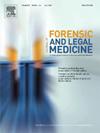两种牙龄估算方法的准确性比较
IF 1.2
4区 医学
Q3 MEDICINE, LEGAL
引用次数: 0
摘要
年龄估计在法医中起着至关重要的作用,特别是在面临与难民有关的重大挑战的国家。有许多参数用于年龄估计。本研究的目的是利用锥形束计算机断层扫描(CBCT)图像评估下颌第三磨牙牙髓和牙周韧带间隙的可见性,并比较这两种方法在实际年龄估计方面的有效性,特别是在评估18-21岁的年龄阈值方面。方法对年龄16 ~ 29岁的359例患者(女性189例,男性170例)的cbct图像进行分析。排除有外伤和/或颌面手术史、下颌骨发育异常或病理、或影响生长发育的全身性疾病的患者。此外,有牙根发育不全、发育或获得性牙畸形、牙髓钙化等情况的第三磨牙也被排除在研究之外。记录患者的年龄和性别后,根据Olze(根髓可见性)和Guo(牙周韧带可见性)将下颌第三磨牙分为0、1、2、3级。每个观察者在两周后重新评估140名随机选择的患者的CBCT图像,以评估观察者内部的可靠性。结果不论性别,Olze评分与Guo评分之间均存在简单相关,两种方法与年龄之间均存在显著正相关(Olze与年龄r = 0.493, p < 0.001; Guo与年龄r = 0.445, p < 0.001)。此外,对于Olze和Guo方法,观察到随着等级的增加,平均年龄也在统计学显著水平上增加(p < 0.001)。Olze和Guo的成绩在18岁和21岁的总阈值上有显著的统计学差异(p < 0.001)。当两种方法以年级为基础进行评估时,发现18岁以下年龄组Olze和Guo 0级评分均有统计学意义升高,18岁及以上年龄组Olze 1级、2级评分和Guo 2级评分均有统计学意义升高(p < 0.001)。在区分18岁以下和18岁以上人群时,发现Olze法的截止值为>; 0, Guo法的截止值为>; 1。研究发现,Olze和Guo的方法在预测18岁阈值方面更为成功。结论虽然Olze分类和Guo分类的准确率很高,但在法医牙龄估计中,18岁和21岁的年龄阈值的确定并非100%准确。然而,对于Olze和Guo方法,平均年龄随着等级的增加而增加。Olze和Guo的方法在估计18岁和21岁的年龄阈值方面都是成功的。本文章由计算机程序翻译,如有差异,请以英文原文为准。
Comparison of the accuracy of two different methods in dental age estimation
Introduction
Age estimation plays a crucial role in forensic medicine, particularly in countries facing significant refugee-related challenges. There are many parameters used for age estimation. The aim of this study is to evaluate the visibility of the pulp and periodontal ligament space in the mandibular third molar using cone beam computed tomography (CBCT) images and to compare the effectiveness of these two methods in chronological age estimation, specifically in assessing the 18–21 age thresholds.
Method
CBCT images of 359 patients (189 females, 170 males), aged between 16 and 29 were analyzed by three independent observers. Patients with a history of trauma and/or surgery in the maxillofacial region, developmental anomalies or pathologies in the mandible, or systemic diseases affecting growth and development were excluded. Additionally, third molars with incomplete root development, developmental or acquired dental anomalies, pulp calcification etc. were excluded from the study. After recording the patients' age and sex, the mandibular third molars were classified according to the Olze (visibility of the root pulp) and Guo classification (visibility of the periodontal ligament) into grades 0, 1, 2, and 3. Each observer re-evaluated the CBCT images of 140 randomly selected patients two weeks later to assess intra-observer reliability.
Results
The simple correlations between Olze and Guo grades were examined regardless of sex, the relationship between both methods and age was found to be significant and positive (Olze vs age r = 0.493 and p < 0.001, Guo vs age r = 0.445 and p < 0.001). Additionally, for both the Olze and Guo methods, it was observed that as the grade increased, mean age also increased at a statistically significant level (p < 0.001). Olze and Guo's grades changed statistically significantly in the 18 and 21 age thresholds in total (p < 0.001). When both methods were evaluated on a grade basis, it was seen that both Olze and Guo grade 0 increased statistically significantly in the under-18 age group, while Olze Grade 1 and Grade 2, and Guo Grade 2 increased statistically significantly in the 18 and over age group (p < 0.001). Olze method's cutoff value was found to be > 0, and Guo method's cutoff value was found to be > 1 in distinguishing between those under 18 and over. Both Olze and Guo's methods were found to be more successful in predicting the 18-year-old threshold.
Conclusion
Although they offer a high probability of being accurate, both Olze and Guo classifications do not provide 100 % accuracy in determining the 18 and 21 age thresholds in forensic dental age estimation. However, for both the Olze and Guo methods, the mean age increased as the grade increased. Both the Olze and Guo methods were found to be successful in estimating the 18 and 21 age thresholds.
求助全文
通过发布文献求助,成功后即可免费获取论文全文。
去求助
来源期刊

Journal of forensic and legal medicine
MEDICINE, LEGAL-
CiteScore
2.70
自引率
6.70%
发文量
106
审稿时长
57 days
期刊介绍:
The Journal of Forensic and Legal Medicine publishes topical articles on aspects of forensic and legal medicine. Specifically the Journal supports research that explores the medical principles of care and forensic assessment of individuals, whether adult or child, in contact with the judicial system. It is a fully peer-review hybrid journal with a broad international perspective.
The Journal accepts submissions of original research, review articles, and pertinent case studies, editorials, and commentaries in relevant areas of Forensic and Legal Medicine, Context of Practice, and Education and Training.
The Journal adheres to strict publication ethical guidelines, and actively supports a culture of inclusive and representative publication.
 求助内容:
求助内容: 应助结果提醒方式:
应助结果提醒方式:


